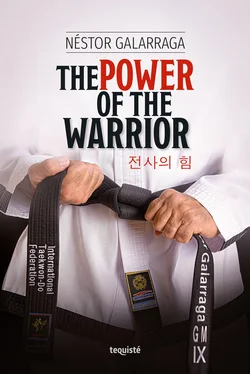Life today demands, given its own dynamics, an enormous capacity to adapt to change; otherwise, we are left outside the system. This phenomenon includes the most diverse social sectors and it touches all areas —personal, couple, friends, partners, etcetera— and it causes vertigo, a feeling of loneliness, fear, insecurity, frustration, resentment, anguish, depression and desperation. If you were born within a family —considered to be the fundamental pillar of our society— and with a conservative mandate to follow (things are for life), it is impossible not to become frustrated if you have to break a relationship or change a partner, family, work, or replace friends. This constitutes a breach in the rules that were established.
In this context, full of contradictory paradoxes, humanity goes after the search of valid alternatives that will allow us to balance and solve existence some way. We are all looking for an exit, a way, a technique, a path, that will let us look a little further, to find a balance and, fundamentally, to live a little bit happier. One of the alternatives —a way in which children and adults expect to feel a little more grounded, secure and with tools to confront life— is to start practicing a martial art; even when they decide to go along without really knowing what they are actually looking for. Most people want to learn how to fight; others, to defend themselves, to feel stronger and more powerful, so as to inspire respect and, maybe, fear; many find the idea of becoming black belts very attractive and appealing; some decide to enter this world because they want everything fast, since they are in a hurry to show others something they believe has to do with inflicting power over others. But they all find something else: a personal practice leading towards the development of their own will power and a profound contact with themselves, and the development of an inner power. It is a practice oriented to learn how to exercise that power from an I can do it philosophy. A power that is not based in others but shared with others. Not to be displayed but to be appreciated, since those others —the trainer and the trainees— made it possible for that power to be within ourselves.
This practice is grounded in our inner self and not in things that are external or that give us power from the outside. It has nothing to do with power or prestige, as seen from the eyes of others, not at the beginning. It is a practice with many qualities: it is exciting; it takes us through the path of becoming men and women of knowledge; its entertaining because, as we start learning more, the awareness and space of all we do not know becomes bigger; it is caring because it builds a tribe, group, family, that holds, embraces and accompanies forever; it is charming because, as we train, without knowing it, we prepare for a change that is complete, permanent and irreversible.
Besides, it is an inspiring practice that teaches us to discover values, to embrace and share them, and to try with others to create a better world.
Martial arts come from East Asia and their introduction into the western world happened at the beginning and middle of the 20th Century. As part of the same package, inseparable from their identity, they were incorporated together with their principles, values, conventions, rituals and symbols, all of which is part of the martial art essence. Thus, they became part of our own culture. It is important to highlight that in its voice and practices reside the art, science, self-defense, sports, moral culture and religion.
Although martial arts are a passionate, entertaining and highly educational practice grounded in our inner self, the topic martial art or martial arts is quite complex to analyze; it is controversial, difficult to address and to understand, if it is not considered under the perspective of its practices. Since they have been little studied, academically, few are the serious investigations carried out in a responsible manner and, generally, statistics with their exceptions —of course, there are some— are prepared using insignificant numbers and the information comes from students all belonging to the same group, school, city or discipline, which considerably limits the global understanding of the martial art as a whole and the authenticity of the information. There are few anthropological, psychological, sociological studies and this constitutes the fundamental enemy of the martial art, the lack of information and seriousness of the sources.
When these investigations are carried out to cover a particular discipline, such as Judo, Karate, Taekwon-Do, etcetera, in most cases, I have noticed that they make small concessions regarding the history, the technique and the philosophy, changing or ignoring small parts that, generally, turn out to be fundamental to understand the guiding thread of the historical, ethnical, cultural, philosophical, religious and technical development of the different disciplines and of martial art as a whole. The same happens within each discipline; many are the differences in the narrative of the different styles of Karate. At the time of addressing the foundational process of the discipline, there is no common denominator between Jiu Jitsu and Judo, and it is worse when we compare Taekwon-Do ITF to WT.
This is fundamentally why the opinions and testimonies of the students, instructors and masters, regarding the different learning experiences, are so valuable when it comes to choosing a discipline or a Dojang to carry out the practice, or to conduct an investigation or analysis that would allow us to come to some serious conclusions. Instructors know that people come to our Dojang by the popular word of mouth and that this is the most effective advertising means for martial arts to be known throughout their history.
The reader will understand that, in general terms, it is still difficult for experts to reflect on a topic that offers few sources of information. Encyclopedias and dictionaries, as well as specialized bibliography of the different disciplines, cannot offer a proper acknowledgment but a subtle attempt to vilify the other disciplines. Even from a sporting point of view, there is little information, difficult to find and, generally, lacking solid foundations, with the exception, of course, of the Olympic disciplines, like Judo and WT Taekwon-Do, which have had the chance to be studied due to the interest of governments.
It is not my intention to make criticism; on the contrary, I am only interested in giving an objective point of view, when trying to describe the current status of the martial arts. The idea of martial arts being uneventful, not studied, investigated or acknowledged is in direct contradiction to the significant social contribution that these disciplines of physical knowledge provide, in general terms, through their practices. Needless to say, these are activities that bring together and embrace groups of people with diverse characteristics, abilities and social backgrounds; through martial arts, people are able to generate tools, resources and opportunities to improve their quality of life, their potential possibilities to grow and adapt to society. The aim of their practices is clearly social diversity in every aspect and, personally, the strengthening of the feeling of self-power and self-esteem. They teach and make people aware of the importance of living in line with a serious scale of values, promoting moral culture and personal ethics.
In Argentina, today, Taekwon-Do is the second most played sport —soccer being first— and martial arts in their entirely constitute, undoubtedly, one of the most solid foundations of the sport. But, of course, nobody says so… It is an open secret… This is mainly because parents chose this discipline for their children because it is a useful educational tool. They do not choose the sport itself; they do not choose WT, ITF in all its different forms or a version of freestyle Taekwon-DO. The choice is based on an educational reason and this is, indeed, really good for our discipline. People choose us because they recognize the seriousness, responsibility, effort and creativity that thousands of instructors, from the many varieties that Taekwon-Do has to offer, express in their classes and, fundamentally, because they recognize in the activity a significant educational power. This is why it is important for those of us who are truly involved with the discipline to try to sharpen our viewpoint about the actual status of martial arts, with the objective to keep building that general vision that society has of these disciplines and to communicate with responsibility the authentic values that are developed through their practices. Be that as it may, the essential part of these disciplines is not found in their history but within their practices.
Читать дальше












